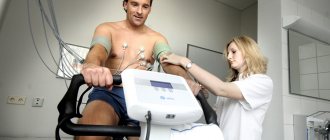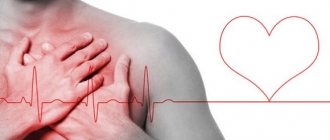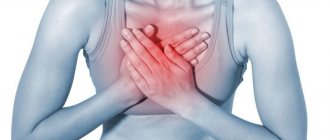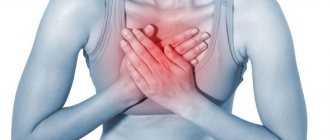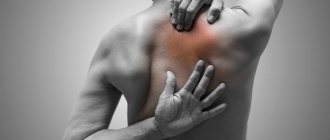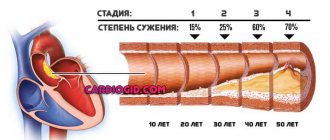Chest pain is a rather unpleasant sensation that can be life-threatening. It is important to react in time to prevent a disaster. The main causes of chest pain: heart, respiratory organs, problems with muscles and bones. Let's look at all possible options.
When pain is deadly
The cause of chest pain is the heart
Why else can you feel chest pain?
Useful VIDEO on chest pain
Diagnosis of chest pain
When pain is deadly
The most dangerous pain sensations are those associated with heart and lung diseases. This condition can be recognized by the following signs:
- The painful sensation lasts more than 5 minutes.
- A sharp burning pain behind the sternum, which gradually spreads to the neck, shoulders and back.
- There is a feeling of pressure and tightness in the chest.
- The heart rate increases greatly, the patient finds it difficult to breathe, and shortness of breath appears.
- The person breaks into a cold sweat, dizziness begins, weakness and nausea with vomiting appear.
If any of the listed symptoms occur, you should immediately call an ambulance.
Treatment of chest pain
It is extremely important to immediately go to a specialist when the first chest pain appears. If the symptom is provoked by any disease, such efficiency will prevent its intensive development.
It is equally important to find a truly competent specialist who works with proven and reliable diagnostic equipment. It is the accuracy of the latter’s testimony that largely determines how accurate the diagnosis will be made and, therefore, the optimal course of treatment will be selected.
A large staff of highly qualified therapists, gynecologists, oncologists, surgeons and ultrasound diagnostic specialists is assembled at JSC “Medicine” (clinic of Academician Roitberg). Conveniently located in the center of Moscow, the medical center building has many comfortable access roads, in particular, it is distinguished by the close location of the Tverskaya, Chekhovskaya, Novoslobodskaya, Belorusskaya and Mayakovskaya metro stations.
Reception of specialists is carried out by appointment. To get a consultation, just call 24/7 +7 (495) 775-73-60 or leave a request for an appointment in the return appointment form on the main page of the clinic’s website.
The cause of chest pain is the heart
The following pathologies can provoke the occurrence of pain in the heart:
- Heart attack. A condition that occurs as a result of a blood clot that blocks one or more arteries that supply blood to the heart. During a heart attack, a sharp, sharp and burning pain occurs behind the sternum.
- Cardiomyopathy. This pathology includes a number of diseases that are united by one symptom - the heart muscle begins to weaken, resulting in difficulties with pumping blood. Pain due to cardiomyopathy may occur after eating or exercising.
- Aortic rupture. The aorta is the largest artery in the human body, which receives blood directly from the heart. Over time, due to heavy load, the walls of the aorta begin to thin and aneurysmal sacs appear, with which a person can live for a long time without any signs of an aneurysm. But sometimes the walls of the aorta cannot withstand it, as a result of which dissection or rupture can occur. This condition is fatal to humans, therefore, in case of sudden acute pain in the chest, which does not subside, is accompanied by dizziness and profuse cold sweating, as well as rapid breathing, it is necessary to urgently call an ambulance.
What to do if you have chest pain?
Inspection and examination of the mammary glands is performed in phase 1 of the cycle from days 1 to 12. All girls and women from 18 to 75 years old, regardless of the presence or absence of complaints, must undergo a routine examination of the mammary glands. It includes:
- Palpation of the mammary glands and self-examination.
Self-examination is carried out once a month. - Ultrasound of the mammary glands
- all women over 18 years old once a year. - Mammography
- all women from 40 to 75 years old once every 2 years
Ultrasound and mammography are complementary research methods and sometimes it is necessary to conduct both studies to obtain the correct diagnosis.
If pathology is present, additional research methods are required:
- MRI (magnetic resonance imaging)
- elastography is an ultrasound method that allows you to detect inflamed areas of tissue and neoplasms
- ductography is a method of x-ray examination of the mammary glands with the introduction of a contrast agent
- thermography - a method for studying the image of temperature distribution over the surface of the mammary glands in order to identify tumor tissue
- examinations to detect mutations of the BRCA 1, BRCA 2 genes (if there is cancer in the family)
- biopsy and other research methods
Pain and benign changes in the mammary glands cannot be ignored. It has been proven that the combination of mastopathy with long-term cyclic pain in the mammary glands increases the risk of developing breast cancer by 5 times!
Why else can you feel chest pain?
Chest pain can be related to the respiratory, digestive and muscle organs.
Respiratory problems
- Pneumonia. Pneumonia is a complication after suffering from influenza or other colds. The patient experiences shortness of breath and severe pain when trying to take a breath.
- Lung collapse. Pneumothorax, or collapsed lung, occurs when air gets trapped between the lungs and the ribs. The patient experiences shortness of breath and severe pain.
- Pleurisy. A disease characterized by inflammation of the pleura. Pain in the chest of a patient with pleurisy occurs during every attempt to take a breath.
- Lungs' cancer. Pain can occur even at rest. This is often accompanied by a wet cough with blood in the sputum.
Digestive problems
Pathologies of the gastrointestinal tract also cause chest pain:
- Heartburn. This condition occurs when gastric juice enters the esophagus. Often with heartburn, a burning sensation appears behind the sternum.
- Diseases of the pancreas and gall bladder. Gallstones or inflammation of the gallbladder can cause pain in the right side of the chest.
- Dysphagia. Pathology characterized by problems with swallowing. In some cases, it can cause severe chest pain.
Muscle and bone problems
Muscle and bone problems causing chest pain:
- Rib injuries. Pain occurs with fractures or bruises of the ribs and soft tissues.
- Fibromyalgia. The disease is characterized by dull pain in the muscles, the nature of which is still unknown. The pain caused by fibromyalgia can last for several months.
- Costochondritis. A disease in which the cartilage connecting the chest and ribs becomes inflamed. Signs of costochondritis resemble a heart attack.
Why do girls and women have chest pain?
The cyclical nature of pain is associated with fluctuations in hormones and is more pronounced in young girls and premenopausal women. This is due to the fact that during the periods of formation and decline of the reproductive system, there is a lack of the phase 2 hormone - progesterone and a relative excess of the phase 1 hormone - estrogen.
A common cause of mastalgia is benign mammary dysplasia or mastopathy - a more well-known term. According to experts, mastopathy occurs in 50-60% of Russian women.
Risk factors for mastopathy:
- early onset of menstruation and late menopause
- abortions
- absence of childbirth and breastfeeding
- menstrual irregularities
- hormone-dependent female diseases (fibroids, endometriosis, endometrial hyperplastic processes)
- hypothyroidism
- increased levels of the hormone prolactin
- diabetes
- liver diseases
- genetic factors
- chronic stress
- sleep disturbance
- dietary errors - excess animal fats, sugar, deficiency of dietary fiber, vitamins and minerals
- alcohol abuse
- consuming large amounts of caffeine
- decreased physical activity
- obesity
Diagnosis of chest pain
In order to make a correct diagnosis explaining the causes of pain, it is necessary:
- Consult a cardiologist
- Take a blood test - general and biochemical; in addition, it is necessary to check the blood for markers of myocardial infarction
- If you have a severe cough, you need to do a sputum test.
- Take an electrocardiogram
- If necessary, supplement with cardiac ultrasound examination
If you experience pain in the chest, you cannot make a diagnosis based on knowledge obtained from the Internet. It is necessary to consult a doctor who will identify the exact cause and prescribe adequate treatment.
Chest pain is any pain or discomfort in the chest area. It can be caused by various diseases, including pathology of the heart, blood vessels, pericardium, lungs, pleura, trachea, esophagus, muscles, ribs, and nerves. In some cases, chest pain is a sign of damage to organs outside the chest, such as the stomach, gallbladder, or pancreas.
Chest pain is very diverse: sharp, dull, aching, cutting, stabbing, pulling, bursting, burning or pressure. Painful sensations vary among different diseases, but pain is not a specific symptom of a particular disease. The characteristics of pain may vary depending on the age, gender of the patient, concomitant diseases, and psychological characteristics. Identifying the immediate cause of chest pain is often difficult and requires a number of diagnostic procedures.
It is one of the most alarming symptoms, as it can be a manifestation of severe, life-threatening conditions that require emergency medical care, in particular myocardial infarction.
Synonyms Russian
Thoracalgia, chest pain, chest pain
English synonyms
Chest pain, pain in the chest, thoracalgia.
Symptoms
Chest pain can be of different types. Sometimes it radiates to the arm, shoulder, shoulder blade, back, neck. The patient may complain not only of pain, but also of tightness, burning, and discomfort in the chest area.
Unpleasant sensations may intensify when coughing, deep breathing, swallowing, pressing on the chest, changing body position (constant or periodic). Chest pain and discomfort may be accompanied by a number of additional symptoms, depending on the underlying disease: belching or bitterness in the mouth, nausea, vomiting, difficulty swallowing.
General information about the disease
Chest pain can be a manifestation of various diseases, each of which requires a specific medical approach.
- Acute myocardial infarction (heart attack). Acute chest pain in people over 40 years of age is most often associated with this disease. Myocardial infarction occurs when a section of the myocardium is damaged and killed as a result of impaired circulation in the coronary vessels. Most often it manifests itself as acute pain behind the sternum or to the left of the sternum, which radiates to the back, neck, shoulder, arm and does not decrease when taking nitroglycerin or at rest. Symptoms vary from patient to patient. Elderly women are characterized by atypical symptoms: severe weakness, nausea and vomiting, rapid breathing, abdominal pain.
- Angina pectoris. A condition in which, as a result of atherosclerosis and narrowing of the coronary vessels, the blood supply to the heart muscle is disrupted. Pain during angina pectoris resembles that during myocardial infarction, but occurs during physical activity, decreases with rest and is relieved by nitroglycerin.
- Dissecting aortic aneurysm. The aorta is a large vessel that carries blood from the left ventricle of the heart to organs and tissues. With a dissecting aneurysm, a rupture of the intima (inner lining) of the aorta occurs with penetration of blood into other layers of the aortic wall and subsequent dissection of the wall, which most often leads to complete rupture of the aorta and massive internal bleeding. The disease in most cases ends in death within a few hours or days, even with timely diagnosis and timely treatment.
Dissecting aortic aneurysm is most often a consequence of long-term arterial hypertension, and can also occur with Marfan syndrome, as a result of chest trauma, during pregnancy, or as a later complication of heart surgery.
Pain with dissecting aortic aneurysm is similar to pain with myocardial infarction and angina pectoris, can last for several hours or days, and does not decrease with rest or with nitroglycerin.
- Pulmonary embolism. Blockage of the pulmonary artery or its branches by a thrombus, through which venous blood flows from the right ventricle to the lungs for oxygen saturation. As a result, gas exchange is disrupted, hypoxia occurs, and pressure in the pulmonary arteries increases. Chest pain occurs suddenly, intensifies with deep inspiration, is accompanied by rapid breathing and, in some cases, hemoptysis. The risk of thromboembolism increases after surgery, prolonged forced immobility, pregnancy, taking oral contraceptives, especially in combination with smoking, and cancer.
- Pneumothorax. The accumulation of air or other gas in the pleural cavity, a slit-like space between the membranes lining the surface of the lungs and the inner surface of the chest. Accompanied by acute chest pain, rapid breathing, anxiety, loss of consciousness.
- Pericarditis. Inflammation of the heart sac (pericardium), that is, the serous membrane of the heart. Pain occurs due to friction of the inflamed pericardial layers. Pericarditis can be a consequence of a viral infection, rheumatoid arthritis, systemic lupus erythematosus, or renal failure. Idiopathic pericarditis, that is, pericarditis of unknown etiology, is common. The pain is acute, occurs only in the initial stages of the disease, and may be accompanied by rapid breathing, fever, and malaise.
- Mitral valve prolapse. Pathology of the valve, which is located between the left atrium and the left ventricle of the heart. In some people, when the left ventricle contracts, the mitral valve bends into the atrium and some of the blood from the left ventricle flows back into the left atrium. For most patients, this does not cause discomfort, but some experience increased heart rate and chest pain that does not depend on physical activity and does not radiate, unlike angina.
- Pneumonia. Inflammation of the lung tissue. Chest pain with pneumonia is usually one-sided, worsens with coughing, and is accompanied by fever, malaise, and cough.
- Esophagitis. Inflammation of the esophagus. Accompanied by chest pain and difficulty swallowing. Symptoms do not improve with antacids.
- Gastroesophageal reflux disease. A chronic disease in which acidic stomach contents reflux into the esophagus, leading to damage to the lower esophagus. In this case, acute, cutting pain in the chest along the esophagus, heaviness, discomfort in the chest, belching, bitterness in the mouth, difficulty swallowing, and dry cough may occur.
- Pleurisy. Inflammation of the pleura. Friction of the inflamed pleura causes pain. Pleurisy can be the result of a viral or bacterial infection, cancer, chemotherapy or radiation therapy, or rheumatoid arthritis.
- Fractured ribs. In this case, the pain intensifies with deep breathing and movement.
- Other causes: pancreatitis, cholelithiasis, depression.
Who is at risk?
- People over 40 years old.
- Obese people.
- Patients with arterial hypertension.
- People with high levels of cholesterol in the blood.
- Have recently undergone surgery.
- Those suffering from alcoholism.
- Smokers.
- Pregnant women.
- Suffering from cardiac arrhythmia.
- People with cancer.
- Taking certain medications.
- People with chronic lung diseases.
Diagnostics
Chest pain is not a specific symptom and can clearly indicate a particular disease. However, when this sign appears, the doctor must first of all exclude a number of life-threatening conditions that require immediate help. Sometimes only additional laboratory and instrumental studies can accurately determine the cause of chest pain.
Laboratory research
- General blood analysis. Leukocytosis (with pleurisy, pneumonia), anemia (with dissecting aortic aneurysm), thrombocytosis and erythremia (with pulmonary embolism) can be detected.
- Erythrocyte sedimentation rate (ESR). Nonspecific indicator of inflammation. ESR can be increased with pleurisy, pericarditis, pneumonia and other diseases.
- C-reactive protein. Increased in inflammatory diseases, as well as in myocardial infarction. With angina, the level of C-reactive protein does not change.
- NT-proBNP (brain sodium uretic propeptide). A protein, the main part of which is found in myocardial cells. It is a precursor of natriuretic peptide, responsible for the excretion of sodium in the urine. This indicator is used to assess the risk of heart failure, identify the initial stages of heart failure, and evaluate therapy. Is highly specific. May be elevated during myocardial infarction.
- Troponin I. Troponin is a protein involved in muscle contraction. The cardiac form of troponin is found in the heart muscle and is released when the myocardium is damaged. It may be increased in myocardial infarction and other diseases accompanied by the destruction of cardiomyocytes.
- Myoglobin. A protein similar in structure to hemoglobin and responsible for the deposition of oxygen in muscle tissue, including the heart muscle. It increases when muscle tissue is damaged, in the first hours after myocardial infarction.
- Alanine aminotransferase (ALT). An enzyme that is found primarily in the liver, as well as in skeletal muscles, kidneys and myocardium. An increase in ALT indicates liver damage, but may also indicate myocardial infarction and serves as an indicator of the extent of damage to the heart muscle.
- Aspartate aminotransferase (AST). This enzyme is found mainly in the myocardium, skeletal muscles, and liver. An increase in AST levels is a sign of myocardial infarction. The AST value corresponds to the degree of damage to the heart muscle.
- Generic creatine kinase. An enzyme involved in energy metabolism reactions. Its different isoforms are found in different tissues of the human body. An increase in the level of total creatine kinase is observed in myocardial infarction and myopathies.
- Creatine kinase MB. An isoform of creatine kinase, which is found mainly in the myocardium and tissues of the nervous system. Its level corresponds to the extent of myocardial damage.
- Lactate dehydrogenase (LDH) total. An enzyme that is involved in energy metabolism and is found in almost all tissues of the body. Different types of LDH are present in different organs. Total lactate dehydrogenase may be elevated in myocardial infarction and liver disease.
- Lactate dehydrogenase 1, 2 (LDH 1, 2 fractions). These are types of lactate dehydrogenase, the increase of which is a more specific indicator of myocardial and kidney damage.
- Lipase. Pancreatic enzyme. Increased lipase levels are specific to pancreatic diseases.
- Total cholesterol. This is the main indicator of fat metabolism in the body. Used to diagnose atherosclerosis and liver diseases.
- D-dimer. Fibrin breakdown product. It is an indicator of fibrinolytic activity of the blood. The level of D-dimer may change with pulmonary embolism, dissecting aortic aneurysm.
- The main blood electrolytes are potassium, sodium, chlorine, calcium. Changes in the level of blood electrolytes may indicate pathology of the kidneys, adrenal glands, endocrine diseases, and malignant neoplasms.
- Urea, serum creatinine. These are the end products of nitrogen metabolism, which are excreted from the body by the kidneys. Their increase may indicate kidney pathology.
Instrumental research methods
- Electrocardiography (ECG). Changes in the ECG are detected during myocardial infarction, angina pectoris, and pericarditis. Helps determine the location and extent of myocardial damage.
- X-ray, computed tomography (CT), magnetic resonance imaging (MRI), ultrasound examination of the chest organs. These are imaging methods that allow you to assess the condition of the chest organs, identify injuries, neoplasms, signs of internal bleeding and other pathological changes.
- Transesophageal echocardiography. An ultrasound examination in which a probe is inserted into the esophagus. With its help, the condition of the heart, its valves, and large vessels is assessed. It has great diagnostic value for pulmonary embolism and aortic aneurysm.
- Angiography. X-ray examination of blood vessels using a non-toxic contrast agent, clearly visible on the images. Allows you to assess the condition and patency of blood vessels, including coronary ones.
Treatment
Treatment depends on the underlying disease, the symptom of which is chest pain. Therapy can consist of both the use of appropriate medications and surgical procedures.
Prevention
There is no specific prevention for most diseases accompanied by chest pain. However, to reduce the risk of their development, quitting smoking and alcohol, sufficient physical activity, a healthy diet, and timely preventive medical examinations are useful.
Recommended tests
- General blood analysis
- Erythrocyte sedimentation rate (ESR)
- C-reactive protein (quantitative)
- NT-proBNP (quantitative)
- Troponin I
- Myoglobin
- Alanine aminotransferase (ALT)
- Aspartate aminotransferase (AST)
- Creatine kinase total
- Creatine kinase MB
- Lactate dehydrogenase (LDH) total
- Lactate dehydrogenase 1, 2 (LDH 1, 2 fractions)
- Lipase
- Total cholesterol
- D-dimer
- Serum potassium
- Serum sodium
- Chlorine in serum
- Serum calcium
- Urea in serum
- Serum creatinine
- Laboratory diagnosis of acute coronary syndrome and myocardial infarction (optimal)
